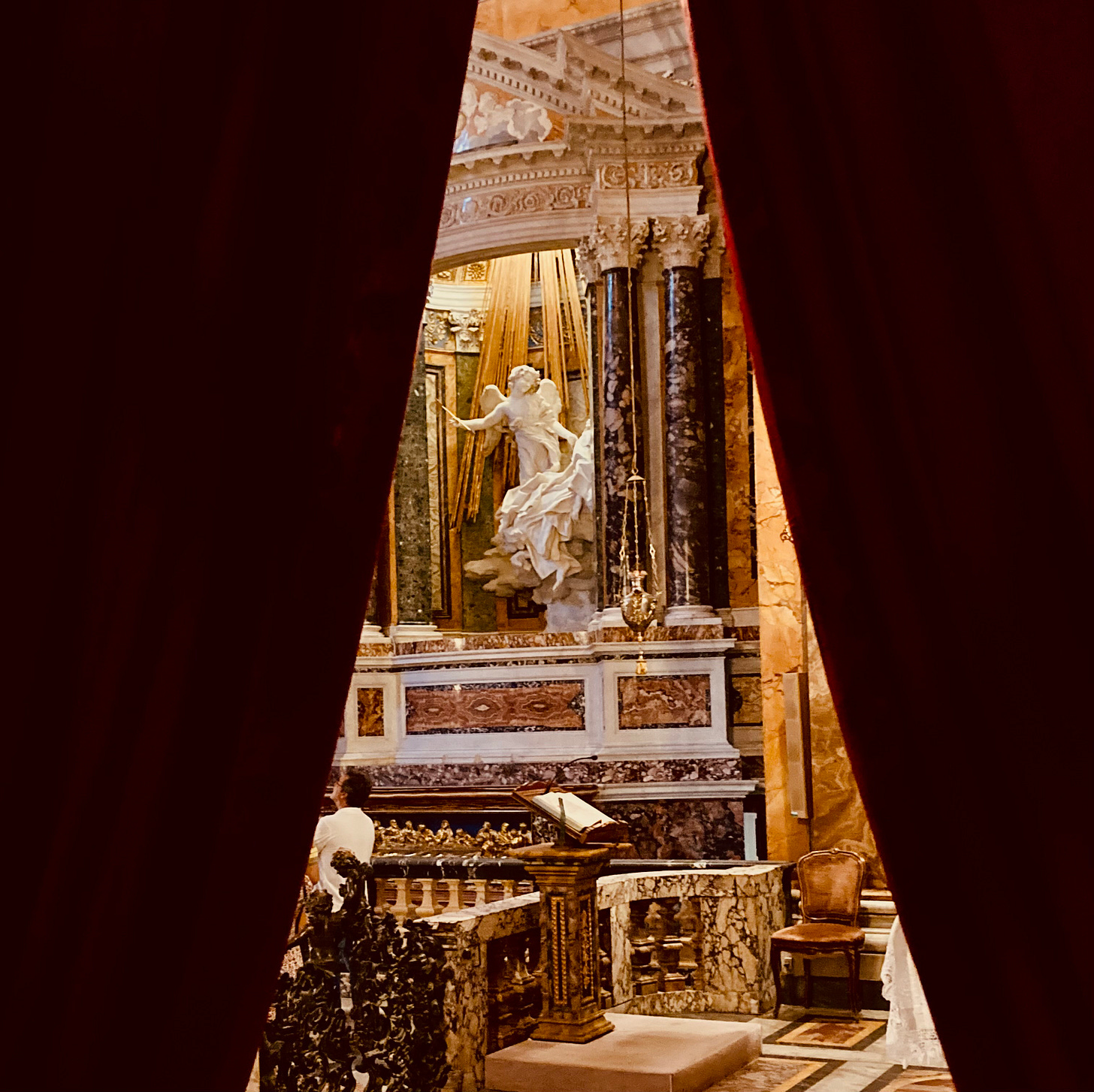Order a copy of the zine vol. ii while they’re still available.
I had the pleasure of interviewing Carlos Eire about his book They Flew: A History of the Impossible, and incredible book about levitating saints. Listen on YouTube, Spotify, or Apple.
And read my review of it in RealClear.
Author Junot Diaz remembers a family member of his in the Dominican Republic who was believed to be a medium that would “become possessed” whenever she heard “certain kinds of music or certain kinds of drums.” In contrast to the rationalism that came to pervade most of Western culture, this “new world cosmology”–as he calls it–which melded Christianity with African and Caribbean indigenous paganism, recognized the transcendent element within everyday experiences ranging from music and the weather to the body and sex.
My maternal grandmother was also born on an island, where Greek Orthodox Christian beliefs and practices were often mixed with folk witchcraft. When she immigrated to the US, she claimed to have visions of the Virgin Mary, to talk to the plants on her balcony, and to receive warnings of impending danger from invisible men. She also claimed to be able to predict the future using the grounds in coffee cups.
A psychiatrist told us her proclivity for magical thinking was the result of her paranoid schizophrenia. Such a diagnosis was difficult for our family to grapple with. The warnings she received from invisible men about people plotting to burn down the house were the stuff of pure delusion. As much as she insisted that “they” had turned the stove on in order to initiate their act of arson, the stove was incontrovertibly flameless. Her paranoia about the women at church talking shit about her sometimes turned out to be true…and sometimes it wasn’t. When the Virgin Mary told her that a doctor would come shortly to save her while she was bleeding to death due to a C-section gone bad, it seems that she was telling the truth. Just like when she read my skeptical aunt’s coffee cup and told her that a woman with strange hair would be traveling by plane (but not overseas) to visit her: The next morning, my aunt’s friend from Florida phoned to tell her she’d be flying to Jersey for a trip.
As much as I had accepted that my grandmother was not a mentally stable person, a part of me wanted to believe that there was more to reality than met the eye…that there were forces–both malevolent and benign–that lurked around the corner of the mundane…and that life wasn’t just about being “a good person,” getting into a good college and starting a stable career path–as my high school guidance counselors insisted…and then dying.
As I began my theological studies in college, I came to find out that I wasn’t the only one who was disillusioned with the kind of life that secular rationalism afforded me. I was affirmed in my intuition that not only was looking at life through such a lens boring and rather depressing, but that the insistence that reality could be reduced to predictable, empirically measurable factors was the product of a socially constructed “project.”
The “post-secular” theorists I read provided me a framework to think through the way I had been conditioned to look at reality: take Charles Taylor’s questioning of the nature of the self, and the alleged “objectivity” of scientific explanations of natural phenomena; John Milbank’s flipping of postmodern skepticism on its own head, debunking the claim that there are “no facts, only interpretations”–which itself was ultimately an “interpretation” of the facts; and Luigi Giussani’s expansion of the concept of “reason” beyond the ability to explain phenomena using empirical data toward the capacity to “understand reality in the totality of its factors.”
In particular, it was the books of Giussani, a Catholic priest tasked with teaching religion in Milan’s rapidly secularizing public high schools, that helped me grapple with the central claim of Christianity: that a human being claimed to be God. While many believe in this claim because of its resonance on an emotional level, Giussani insisted that this claim is either a fact or not. And that one can only verify the authenticity of this fact through their lived experience.
It was through very concrete encounters with people at my university that I discovered the extent to which Christianity was capable of answering to the needs–for beauty, truth, justice, love–that plagued my day to day existence: a vivacious philosophy professor who introduced me to the works of Plato and Teresa of Ávila, a disarmingly gentle and patient Jesuit priest who listened to me cry about my questions and anxieties, and a group of students who sought beauty and meaning in everything ranging from their studies to partying at a bar.
Yale professor Carlos Eire lays the foundation of his latest book, They Flew: A History of the Impossible, with these “post-secularist” pretensions. He sets out to write a history of people who levitated, focusing primarily on Roman Catholic saints and practitioners of witchcraft and the occult, while also acknowledging levitators from the world’s other religious traditions. He makes clear that as a historian, he is seeking not to offer a theological or hagiographical account of said levitators, but to inquire into the facticity of their stories.
…
But perhaps what’s most remarkable about the book is how masterfully it traces the development of the Catholic Church’s understanding of levitators in response to its numerous detractors. The Church has always been aware of occultists and witches who claimed to manifest miraculous feats relying on the power of ungodly forces. Its determination to weed out the diabolical levitators from the godly ones was further fueled by attacks of Protestant reformers who insisted that all supernatural feats were the work of the devil. On top of this, the expansion of scientific rationalism, brought on by Enlightenment thinkers, sought to discredit any beliefs or events that defied the “laws of nature.” Over time, the Church’s criterion for judging the authenticity of miracles came to include the expertise of doctors and scientists–whose job it was to rule out any possible empirical explanations, and the “devil’s advocate”–who was tasked with attempting to disprove the sanctity of the miracle-worker in question.
Essential to proving the veracity of a levitator was his or her holiness–their overall moral stature and living in harmony with the ideals of the Church. Unlike ungodly levitators who were self-aggrandizing, seeking worldly power or esteem for themselves, the holy levitator served a higher purpose: Their miraculous accomplishments gave glory to God and edified the faith of others, feeding their need for hope and offering consolation in their worldly suffering. What distinguished her from a “witch” or “magician” is that her miracles outwardly manifested the presence of a benevolent God, whose existence was, although invisible, an objective, dynamic reality. Thus, her levitation brought people into closer contact with that intangible Being who promises to satisfy the very real, deeply rooted need for meaning that rests at the depths of the human soul.
While modern rationalism’s near-fundamentalist devotion to objectivity posed considerable challenges to all belief systems that give credence to miraculous happenings–be they monotheistic, polytheistic, occultic, or Spiritualist–Eire highlights that the dawn of postmodernism has served to simultaneously erase and re-legitimize the credibility of said belief systems. The same relativist impulse that might cause someone to declare that “God is dead” might also lead someone to dismiss the scientist who denies the plausibility of supernatural occurrences. Postmodernism may downplay the dogmatic dimension of organized religions but is more willing to concede that seemingly “irrational” events are indeed possible…if that happens to resonate as your “personal truth.”
When asked whether he thought the Christian belief in the resurrection of the body was a metaphor, the Puerto Rican priest and physicist Lorenzo Albacete replied, “My experience of the body is not the experience of a metaphor. The day this baby becomes a metaphor, I’ll be better equipped to answer your question.”
Albacete, a rather rotund man, continued by poking fun at the irony of his last name (in English, a “white whale”), contrasting this with the bodies he saw in southern California, which “make you think of the resurrection as a worthwhile thing, as a metaphor for their beauty and attraction…What my heart wants, is the real possibility of having a body like those who at that very moment could be seen around the pool during the shooting of an episode of some television series. I have no idea what my risen body might be like, but if such a thing does exist, I want it to be closer to the bodies at the pool than to a metaphor.”
Eire welcomes the space that postmodernism has afforded to post-secular narratives, while–as a historian–being critical of the relativist reading of miraculous events. At the end of the day, either “they flew,” or they did not. The problem with applying the “to each, their own” logic to the question of levitation is that the miracle’s value is directly linked to the objectivity of its origin. If it is indeed a work of God, the miracle has a radically different effect than if it is the work of the devil, or if it is the result of a chemical reaction…or the mere figment of one’s delusional imagination. As Albacete indicated, our need for beauty, for meaning in the midst of suffering, for happiness–our need for “salvation”–is anything but metaphorical. They are concrete facts that shade our everyday lives. If levitations were purely symbolic or metaphorical events–that is, not factitious–then their value is ultimately nullified. To borrow a line from Flannery O’Connor when she was questioned about the nature of the Eucharist, if miracles are all just metaphors, “then to hell with [them].”
Eire’s book is an anomaly. His research on levitation manages to evade being both the purely hagiographic and rationalistic–a feat perhaps only possible in our current “post-postmodern,” post-secular ethos. I finished the book feeling inclined to believe that the impossible is indeed possible…yet I couldn’t help but also feel disappointed. While I do believe that plenty of holy people indeed flew, I highly doubt I will ever be counted among them.
Giussani defines a miracle as “an event, an experienceable fact by which God forces us to pay heed to him…to take notice of his Reality.” While some miracles constitute an “extraordinary appeal” that defies the laws of nature, he concedes that when we look closely, we’ll see that “all things are a miracle.” I doubt that my life living in 21st century New York will look very much like that of Teresa of Ávila–as much as she may have captivated me the first time that quirky philosophy professor handed me a copy of her autobiography. But the event of having encountered people such as that professor who opened the door for me to a new way of seeing reality–of living, of loving, and enjoying my existence–is in itself a miracle.
Continue reading at RealClear.





